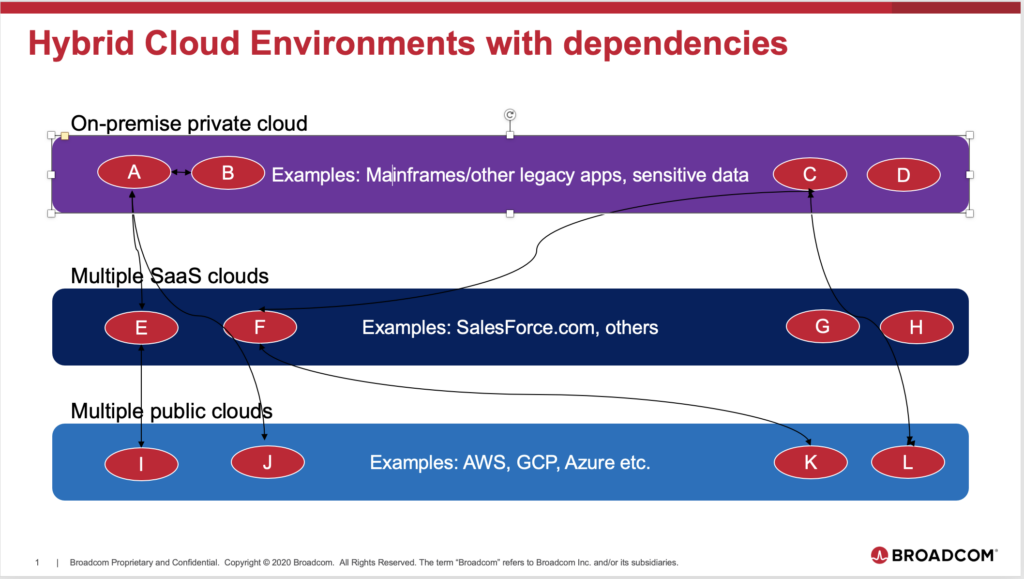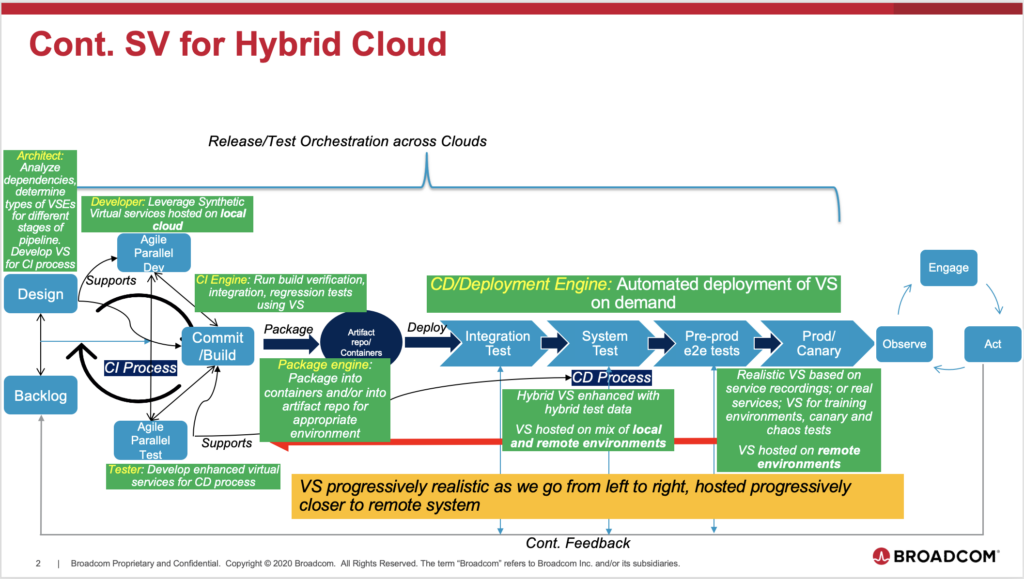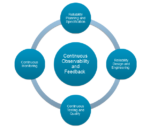(First of two parts)
Several weeks ago, a customer of the Broadcom Service Virtualization solution posed the following question: “Now that we’re moving to the cloud, do we still need Service Virtualization?”
The question struck me as odd. My sense is that this confusion probably stemmed from the misperception that, since cloud environments can be spun up quickly, people think they can easily address test environment bottlenecks and, in the process, service virtualization capabilities would be rendered unnecessary. Obviously, that is not the case at all! Being able to spin up infrastructure quickly does not address the issue of what elements need to be established in order to make environments useful for desired testing efforts.
In fact, all the use cases for the Service Virtualization solution are just as relevant in the cloud as they are in traditional on-premises-based systems. Following are a few key examples of these use cases:
- Simplification of test environments by simulating dependent end points
- Support for early, shift-left testing of application components in isolation
- Support for performance and reliability engineering
- Support for integration testing with complex back-ends (like mainframes) or third-party systems
- Simplification of test data management
- Support for training environments
- Support for chaos and negative testing
All of these use cases are documented in detail here.
Further, what’s more pertinent is that Service Virtualization helps to address many additional use cases that are unique to cloud-based systems.
Fundamentally, Service Virtualization and cloud capabilities complement each other. Combined, Service Virtualization and cloud services deliver true application development and delivery agility that would not be possible with only one of these technologies.
Using virtual services deployed to an ephemeral test environment in the cloud makes the setup of the environment fast, lightweight, and scalable. (Especially compared to setting up an entire SAP implementation in the ephemeral cloud environment, for example.)
Let’s examine some key ways to use Service Virtualization for cloud computing.
Service Virtualization Use Cases for Cloud Migration
Cloud migration typically involves re-hosting, re-platforming, re-factoring, or re-architecting existing systems. Regardless of the type of migration, Service Virtualization plays a key role in functional, performance, and integration testing of migrated applications—and the use cases are the same as those for on-premises applications.
However, there are a couple of special use cases that stand out for Service Virtualization’s support for cloud migration:
- Early Pre-Migration Performance Verification and Proactive Performance Engineering
In most cases, migrating applications to the cloud will result in performance changes, typically due to differences in application distribution and network characteristics. For example, various application components may reside in different parts of a hybrid cloud implementation, or performance latencies may be introduced by the use of distributed cloud systems.
With Service Virtualization, we can easily simulate the performance of all the different application components, including their different response characteristics and latencies. Consequently, we can understand the performance impact, including both overall and at the component level, before the migration is initiated.
This allows us to focus on appropriate proactive performance engineering to ensure that performance goals can be met post migration.
In addition, Service Virtualization plays a key role in performance testing during and after the migration, which are common, well-understood use cases.
2. Easier Hybrid Test Environment Management for Testing During Migration
This is an extension to the common use case of Service Virtualization, which is focused on simplifying testing environments.
However, during application migration this testing becomes more crucial given the mix of different environments that are involved. Customers typically migrate their applications or workloads to the cloud incrementally, rather than all at once. This means that test environments during migration are much more complicated to set up and manage. That’s because tests may span multiple environments, both cloud, for migrated applications—and on-premises—for pre-migration applications. In some cases, specific application components (such as those residing on mainframes), may not be migrated at all.
Many customers are impeded from early migration testing due to the complexities of setting up test environments across evolving hybrid systems.
For example, applications that are being migrated to the cloud may have dependencies on other applications in the legacy environment. Testing of such applications requires access to test environments for applications in the legacy environment, which may be difficult to orchestrate using continuous integration/continuous delivery (CI/CD) tools in the cloud. By using Service Virtualization, it is much easier to manage and provision virtual services that represent legacy applications, while having them run in the local cloud testing environment of the migrated application.
On the other hand, prior to migration, applications running in legacy environments will have dependencies on applications that have been migrated to the cloud. In these cases, teams may not know how to set up access to the applications running in cloud environments. In many cases, there are security challenges in enabling such access. For example, legacy applications may not have been re-wired for the enhanced security protocols that apply to the cloud applications.
By using Service Virtualization, teams can provision virtual services that represent the migrated applications within the bounds of the legacy environments themselves, or in secure testing sandboxes on the cloud.
In addition, Service Virtualization plays a key role in parallel migrations, that is, when multiple applications that are dependent on each other are being migrated at the same time. This is an extension of the key principle of agile parallel development and testing, which is a well-known use case for Service Virtualization.
3. Better Support for Application Refactoring and Re-Architecting During Migration
Organizations employ various application re-factoring techniques as part of their cloud migration. These commonly include re-engineering to leverage microservices architectures and container-based packaging, which are both key approaches for cloud-native applications.
Regardless of the technique used, all these refactoring efforts involve making changes to existing applications. Given that, these modifications require extensive testing. All the traditional use cases of Service Virtualization apply to these testing efforts.
For example, the strangler pattern is a popular re-factoring technique that is used to decompose a monolithic application into a microservices architecture that is more scalable and better suited to the cloud. In this scenario, testing approaches need to change dramatically to leverage distributed computing concepts more generally and microservices testing in particular. Service Virtualization is a key to enabling all kinds of microservices testing. We will address in detail how Service Virtualization supports the needs of such cloud-native applications in section IV below.
4. Alleviate Test Data Management Challenges During Migration
In all of the above scenarios, the use of Service Virtualization also helps to greatly alleviate test data management (TDM) problems. These problems are complex in themselves, but they are compounded during migrations. In fact, data migration is one of the most complicated and time-consuming processes during cloud migration, which may make it difficult to create and provision test data during the testing process.
For example, data that was once easy to access across applications in a legacy environment may no longer be available to the migrated applications (or vice-versa) due to the partitioning of data storage. Also, the mechanism for synchronizing data across data stores may itself have changed. This often requires additional cumbersome and laborious TDM work to set up test data for integration testing—data that may eventually be thrown away post migration. With Service Virtualization, you can simulate components and use synthetic test data generation in different parts of the cloud. This is a much faster and easier way to address TDM problems. Teams also often use data virtualization in conjunction with Service Virtualization to address TDM requirements.
Service Virtualization Use Cases for Hybrid Cloud Computing
Once applications are migrated to the cloud, all of the classic use cases for Service Virtualization continue to apply.
In this section, we will discuss some of the key use cases for supporting hybrid cloud computing.
- Support for Hybrid Cloud Application Testing and Test Environments
Post migration, many enterprises will operate hybrid systems based on a mix of on-premises applications in private clouds (such as those running on mainframes), different public cloud systems (including AWS, Azure, and Google Cloud Platform), and on various SaaS provider environments (such as Salesforce). See a simplified view in the figure below.

Setting up test environments for these hybrid systems will continue to be a challenge. Establishing environments for integration testing across multiple clouds can be particularly difficult.
Service Virtualization clearly helps to virtualize these dependencies, but more importantly, it makes virtual services easily available to developers and testers, where and when they need them.
For example, consider the figure above. Application A is hosted on a private cloud, but dependent on other applications, including E, which is running in a SaaS environment, and J, which is running in a public cloud. Developers and testers for application A depend on virtual services created for E and J. For hybrid cloud environments, we also need to address where the virtual service will be hosted for different test types, and how they will be orchestrated across the different stages of the CI/CD pipeline.
See figure below.

Generally speaking, during the CI process, developers and testers would like to have lightweight synthetic virtual services for E and J, and to have them created and hosted on the same cloud as A. This minimizes the overhead involved in multi-cloud orchestration.
However, as we move from left to right in the CD lifecycle, we would not only want the virtual services for E and J to become progressively realistic, but also hosted closer to the remote environments, where the “real” dependent applications are hosted. And these services would need to orchestrate a multi-cloud CI/CD system. Service Virtualization frameworks would allow this by packaging virtual services into containers or virtual machines (VMs) that are appropriate for the environment they need to run in.
Note that it is entirely possible for application teams to choose to host the virtual services for the CD lifecycle on the same host cloud as app A. Service Virtualization frameworks would allow that by mimicking the network latencies that arise from multi-cloud interactions.
The key point is to emphasize that the use of Service Virtualization not only simplifies test environment management across clouds, but also provides the flexibility to deploy the virtual service where and when needed.
2. Support for Agile Test Environments in Cloud Pipelines
In the introduction, we discussed how Service Virtualization complements cloud capabilities. While cloud services make it faster and easier to provision and set up on-demand environments, the use of Service Virtualization complements that agility. With the solution, teams can quickly deploy useful application assets, such as virtual services, into their environments.
For example, suppose our application under test has a dependency on a complex application like SAP, for which we need to set up a test instance of the app. Provisioning a new test environment in the cloud may take only a few seconds, but deploying and configuring a test installation of a complex application like SAP into that environment would take a long time, impeding the team’s ability to test quickly. In addition, teams would need to set up test data for the application, which can be complex and resource intensive. By comparison, deploying a lightweight virtual service that simulates a complex app like SAP takes no time at all, thereby minimizing the testing impediments associated with environment setup.
3. Support for Scalable Test Environments in Cloud Pipelines
In cloud environments, virtual service environments (VSEs) can be deployed as containers into Kubernetes clusters. This allows test environments to scale automatically based on testing demand by expanding the number of virtual service instances. This is useful for performance and load testing, cases in which the load level is progressively scaled up. In response, the test environment hosting the virtual services can also automatically scale up to ensure consistent performance response. This can also help the virtual service to mimic the behavior of a real automatically scaling application.
Sometimes, it is difficult to size a performance testing environment for an application so that it appropriately mimics production. Automatically scaling test environments can make this easier. For more details on this, please refer to my previous blog on Continuous Performance Testing of Microservices, which discusses how to do scaled component testing.
4. Support for Cloud Cost Reduction
Many studies (such as one done by Cloud4C) have indicated that enterprises often over-provision cloud infrastructure and a significant proportion (about 30%) of cloud spending is wasted. This is due to various reasons, including the ease of environment provisioning, idle resources, oversizing, and lack of oversight.
While production environments are more closely managed and monitored, this problem is seen quite often in test and other pre-production environments, which developers and teams are empowered to spin up to promote agility. Most often, these environments are over-provisioned (or sized larger than they need to be), contain data that is not useful after a certain time (for example, including aged test data or obsolete builds or test logs), and not properly cleaned up after their use—developers and testers love to quickly move on the next item on their backlog!
Use of Service Virtualization can help to alleviate some of this waste. As discussed above, replacing real application instances with virtual services helps to reduce the size of the test environment significantly. Compared to complex applications, virtual services are also easier and faster to deploy and undeploy, making it easier for pipeline engineers to automate cleanup in their CI/CD pipeline scripts.
In many cases, virtual service instances may be shared between multiple applications that are dependent on the same end point. Automatically scaling VSEs can also help to limit the initial size of test environments.
Finally, VSEs to which actual virtual services are deployed, can be actively monitored to ensure tracking, usage, and de-provisioning when not used.







